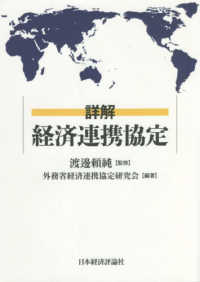Full Description
The 3rd edition of The ESL Writer's Handbook continues to be a valuable resource that offers non-native English speakers, particularly international students, a foundation in the basics of the academic writing genre they need to succeed in high school- or college-level writing. By focusing on English for Academic Purposes, it helps address the broad variety of writing questions students may have while working on school assignments. It can act as a complement to a student's dictionary, thesaurus, and grammar reference book, or as a core text in an advanced-level ESL writing course. With explanatory language that avoids unnecessary idioms and incorporates writing examples from real international students, The ESL Writer's Handbook will help students build their confidence in English language writing.
In addition to updated style guides, sample student papers, writing examples, and exercises, the 3rd edition highlights "tech tips" on different technologies that may be useful to students, explains inclusive language, and expands the section on taking notes as a research tool.
With this handbook, students will learn:
The concept of genre and apply it to unpacking assignments and writing effectively.
The process for generating ideas, structuring those ideas into a paper, and checking over a paper before turning it in.
Five common patterns for organizing an academic essay: narrative, process, comparison/contrast, cause and effect, and argument.
Different steps for creating a good research paper, including major citation styles.
Guidance for addressing the grammar, punctuation, and style issues most often encountered by international students writing in English.
How to differentiate between other types of writing U.S. undergraduate students are expected to complete, such as emails, resumes, cover letters, and personal statements.
CEFR Levels: B1-C2
Contents
SECTION 1. THE WRITING PROCESS
A. Before You Get Started
B. Understanding the Stages in the Writing Process
SECTION 2. ESSAY STRUCTURE
A. Shaping a Paragraph
B. Shaping an Essay
C. Re-Reading and Revising the Essay
D. A 10-Step Guide to the Writing Process
E. Sample Essay
SECTION 3. PATTERNS OF ESSAY ORGANIZATION
A. Narrative Essay
B. Process Essay
C. Comparison/Contrast Essay
D. Cause-and-Effect Essay
E. Argument Essay
F. Combining Patterns of Organization
SECTION 4. RESEARCH PAPER
A. Choosing a Topic
B. Finding Sources to Support Your Topic
C. Taking Notes
D. Summarizing, Paraphrasing, and Using Quotations
E. Outlining
F. Writing Thesis Statements
G. Writing Complete Drafts
H. Proofreading
I. Citation Style Guides
J. APA Style: References, Format, and Sample Paper
K. MLA Style: Works Cited, Format, and Sample Paper
L. Chicago Manual of Style: References, Footnotes and Bibliography
M. IEEE Style: References
SECTION 5. GRAMMAR AND STYLE
USING INCLUSIVE AND UNBIASED LANGUAGE
GRAMMAR AND STYLE AT WORD LEVEL
A. Word Form
B. Articles
C. Prepositions
D. Word Choice in Formal Writing Style
E. Reference Words: Pronouns and Synonyms
F. Reducing Wordiness
G. Parts of a Sentence
H. Subject-Verb Agreement
I. Run-On Sentences and Sentence Fragments
J. Comma Splice
K. Adjective Clauses
L. Parallel Structure
M. Sentence Combining
N. Sentence Variety
SECTION 6. PUNCTUATION
A. Period
B. Question Mark
C. Exclamation Point
D. Comma
E. Semicolon
F. Colon
G. Hyphen
H. Dash
I. Double Quotation Marks
J. Single Quotation Marks
K. Parentheses
L. Brackets
M. Apostrophe
N. Ellipsis
O. Capital Letters
P. Indentation of Paragraphs and Quotations
Q. Abbreviation Period
SECTION 7. QUICK REFERENCE
A. Connections between Ideas
B. Words Often Confused
C. Active and Passive Voice
D. Verb Tenses








